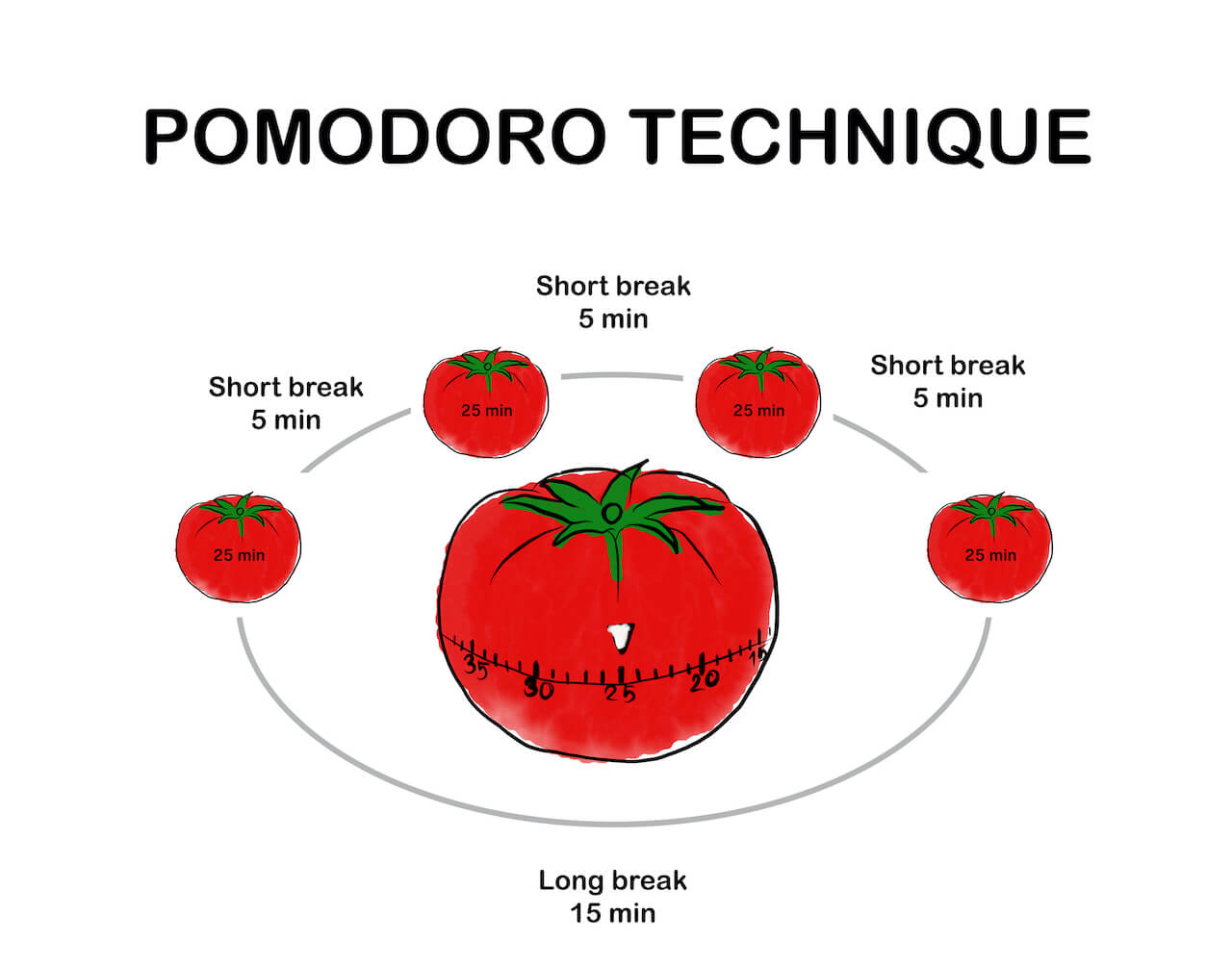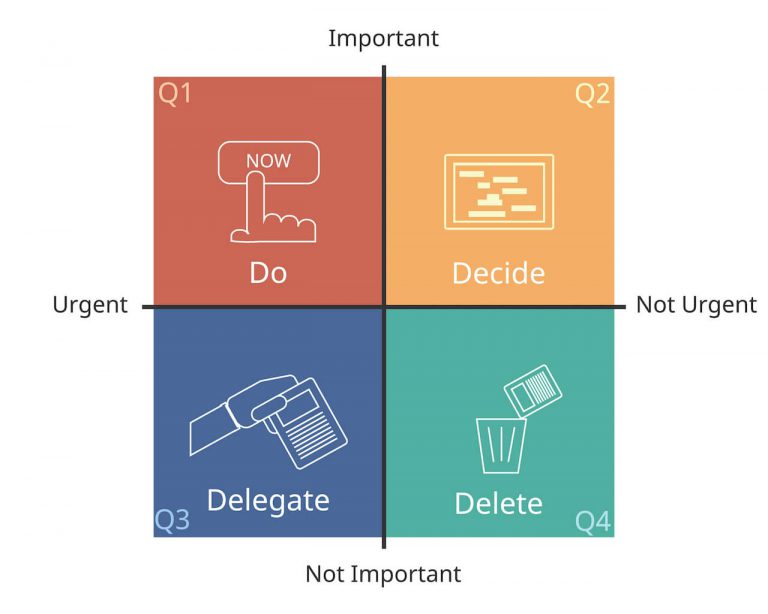How to Use the Pomodoro Technique
What is it?
Francesco Cirillo created the Pomodoro technique while a student in the ’80s. It is essentially a technique to help you manage your time and be more productive.
Pomodoro means tomato in Italian. Cirillo had a timer in the shape of a tomato, hence why he named the Pomodoro technique. Of course, it isn’t necessary to have a Pomodoro timer to use the technique, but it does make it slightly more fun!
The Pomodoro technique uses a system called Timeboxing. This means fixing a set time for one task or activity and stopping when the time is up, regardless of your progress. This technique can help prevent activity consumption, particularly one with no set stopping point.
For example, looking at your social media feed can take five minutes or five hours, depending on how consumed you become by it. Suddenly, you have wasted half the day, achieved nothing, and increased your stress levels. Setting a timer to tell you when to stop can help reduce procrastination and distractions.
How do you use it?
Everyone has different ways of working, so they may use the Pomodoro technique at different time intervals. However, the best way to start is to try 25 minutes of work time, followed by five minutes of break. This is one Pomodoro!
Do this four times and then take a longer break of 15-30 minutes.
Follow these five easy steps:
- Identify tasks that need to be completed and choose one
- Set a timer for 25 minutes
- Work on the task until the timer rings
- Take a break of 5 minutes
- For each Pomodoro, take a 15-30 minute break
It is essential to stay focused on a single task during the 25 minutes without becoming distracted. If you have a thought or idea that needs to be followed up, write it down to return to after your focused work. Depending on how distracted you become, a single distraction could derail your progress by hours, as it can be a challenge to refocus.
How important is the timing?
Some people who use the Pomodoro technique continue working after the timer goes off. This can be a good thing because you get into the work and get more done. However, it can cause you to slip back into old habits without realizing it. If you don’t stick to the timer, you might reverse any positive routines you created using the Pomodoro technique.
The short focus time and regular breaks act as a reward system, which subconsciously encourages you to work. If you don’t allow yourself these frequent breaks, you might discourage yourself without even noticing.
If you are new to the Pomodoro technique, it is advisable to stick to a 25-minute work, 5-minute brake system. This will help you to build and ingrain positive habits. However, if you have used this technique several times, it is possible to change the timing successfully.
Changing your timings
You might find that a longer work time with a longer break time is a more motivating system for you. On the other hand, perhaps your work requires long periods of concentration. In this case, you might want to try 60 minutes of work with a 15-minute break. Adapt your Pomdoros to work for you, but always be mindful of your limits.
You can also alter the length of your Pomodoros depending on the type of work you are doing. If it requires a great deal of concentration or energy, you might want to set a timer for a short time. You can keep returning to work after each break with renewed energy and avoid burnout.
Why is it good?
Bitesize chunks
When faced with a big task, it is widespread to feel overwhelmed. This can cause you to feel reluctant to get started as it can seem like there is an endless amount of work. Sometimes this can stop you from starting a task and finding ways to put it off. Often in these cases, though, once you get round to it, the task isn’t all that bad! Just starting a task is the most challenging part for some people, and the Pomodoro technique can help tackle this.
Breaking things down into smaller chunks and 25-minute intervals can make a task feel more manageable. The Pomodoro technique encourages short bursts of focused work with an opportunity to recharge before starting the next one. This can make tasks feel less daunting and easier to begin. Plus, you know you get a break after 25 minutes which can be a good motivation.
Getting started
The Pomodoro technique makes it feel a lot easier to get started on a task and helps you to build momentum. Once you get going, you will find you can be much more productive.
Then, the rewarding feeling of accomplishing something helps you to want to keep going. Short bursts of work, with short breaks in between, can encourage better focus and motivation.
For this reason, it is beneficial to start the day with a Pomodoro. Then you have built some momentum up first thing and may not even need to use many Pomodoros for the rest of the day to be productive. You might find that this initial motivation is enough to keep you focused throughout the day.
Reduce distractions
On the other hand, if you struggle to retain focus, you might want to plan your whole day with Pomodoros. This can help eliminate distractions and procrastination and retrain your focus on the tasks at hand.
Often, it isn’t even our phones or other people that are the most distracting, but ourselves! It can be widespread to find your mind wandering. Then you might struggle to return your attention to your work. Having a set plan with a specific timeframe can help to reduce these distractions and keep your focus.
If you still find that you are getting distracted or your mind is wandering, you can change the timings to work for you. For example, you might want to try ten or even 5-minute stints. This might help to encourage focus, and then you can work up to 25 minutes as this improves.
The more times you use a Pomodoro, the easier it will become to focus. It will soon become a habit, and you will find you don’t slip back into those procrastinating ways!
Reduce fatigue
Some people are more productive in the mornings, while others are more productive in the afternoon. But what is true for most of us is that the longer we work, the more tired our brain becomes.
This is why taking regular breaks can help with productivity. It allows you to recharge and return to your work feeling refreshed and ready to focus again. This is particularly helpful if you have to work on a computer all day.
Your eyes can become very tired from staring at the screen, so having regular breaks away from the screen. Sometimes, work can be so boring or exhausting that you start to feel your eyes close! Again, taking those 5-minute breaks after every Pomodoro can help you wake up and stay focused.
This way, you can be at your most productive for the entire day and achieve a whole lot more than before!
How many Pomodoros a day?
If you consider that most people work for 8 hours per day, you might think that you should plan for 16 Pomodoros. But take breaks for eating, using the toilet, checking emails, and various other distractions. This probably brings the total number of hours worked to around 4-6 hours.
You could plan for 8-12 Pomdoros a day with this calculation. However, in practice, even this might be a lot if you consider that this is entirely focused work time.
When using the Pomodoro technique, you should be thinking more about quality than quantity. For example, if you struggle to complete more than 4 Pomodoros per day, but this is productive time, then work with that.
It’s no use to try and pack in as many Pomodoros as you can every day if the result is poor attention or poor quality work.
Practice using the technique and see what works for you, adjusting as needed. If you cannot focus for the time of two Pomodoros, then this is an issue. Two Pomodoros equates to one hour, so this should not feel difficult to accomplish.
Adapt as required
Work on an absolute minimum of two Pomodoros a day, with a maximum of around 14. Any less, and you will achieve very little. Any more, and you could burn yourself out. You can review this at the end of each day and alter your plan for the following day.
During your daily review, consider how much work you have completed, the quality, and any physical or mental effects this workload has had on you.
Overworking can be as unproductive as procrastinating if you wear yourself out. The number of Pomodoros you complete doesn’t always relate to the amount of work accomplished.
What can I do during my 30-minute break?
For every four Pomodoros you complete, you can reward yourself with a 15-30 minute break. You can do whatever you like during this time to refresh and refocus your mind.
There is only one rule. If you have been working on a screen, step away from your desk! Don’t look at your phone or any other screen! This will add to your fatigue and make it harder to get back to your work.
Do something enjoyable or useful. Maybe put on a load of laundry, walk the dog, and prepare some food. These things need doing from day to day and could help you feel less stressed when you go back to your desk.
Alternatively, do some gentle stretching or exercise to loosen up your body and get the oxygen flowing to the brain. Remember to reward yourself for your hard work. Let this break be an enjoyable distraction, so you return to your work feeling rejuvenated.
5-minute breaks
Similarly, during your short breaks, try to avoid looking at your phone. During these breaks, it is even more important to step away from the screen as it is just a short time to feel refreshed.
Maybe make some coffee or grab a snack. Move your body a bit before you sit back down to ensure you feel the benefits of the break.
Tips
Break it down: If you have a complex project to complete, it might require numerous Pomodoros. Anything over four or five needs to be broken down into smaller tasks. Try to allocate just one or two Pomodoros per task to make it more manageable.
Combine tasks: If you have several tasks to complete that will take less than one Pomodoro, then combine them. Have a list of short tasks that need completing.
For example, making a dentist appointment, adding an event to your diary, or ordering a new printer cartridge. You can allocate a number of these tasks to one Pomodoro, so you are still using your time effectively.
No pausing: Once you set a timer, you cannot turn it off! If something distracts you or pops into your head, make a note of it and return to it later. Don’t pause the timer once it has started unless it is something urgent.
Plan your day with Pomodoros: Compile a list of all the tasks you need to complete and consider how long each task will take. Then allocate each task to a set number of Pomodoros. This will give you a better idea of how you use your time and help you make realistic plans every day.
Remember not to over-plan or try and squeeze too much into one day. Instead, prioritize each task to know you have worked on the most important tasks if you cannot complete everything.
Make it fun: Set daily goals and make work feel more like a game. Strive to improve each day by completing more Pomodoros or finishing work before the timer rings. Remember not to compromise on quality as you do this. Working towards goals can improve efficiency and productivity and help to reduce distraction time.
Start using the Pomodoro technique today!
Many people have found that this technique helps them improve their productivity. Try using Pomodoros for yourself and see if it works for you. You might find that your time management suddenly improves, and work doesn’t feel so daunting.
Having something to look forward to during your short or longer breaks can help you feel motivated throughout your work time. Plus, starting on your work first thing won’t feel so difficult if you know you have something to look forward to later.
Your perception of time could change dramatically too. Any anxieties about your work time might dissolve as you find your productivity improving. And who doesn’t want to feel less stressed about work!?
Using the Pomodoro technique could help you create consistent and positive work habits. You will be surprised at how much more productive you can be! To make life and work easier for yourself and give it a go today!





